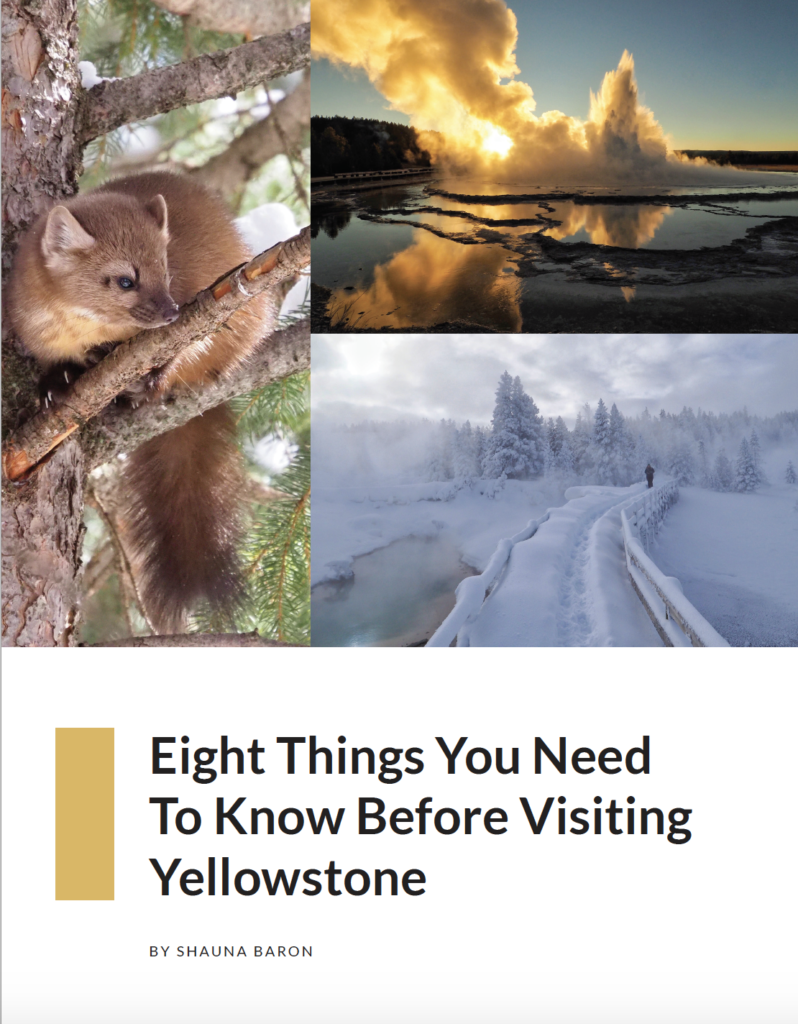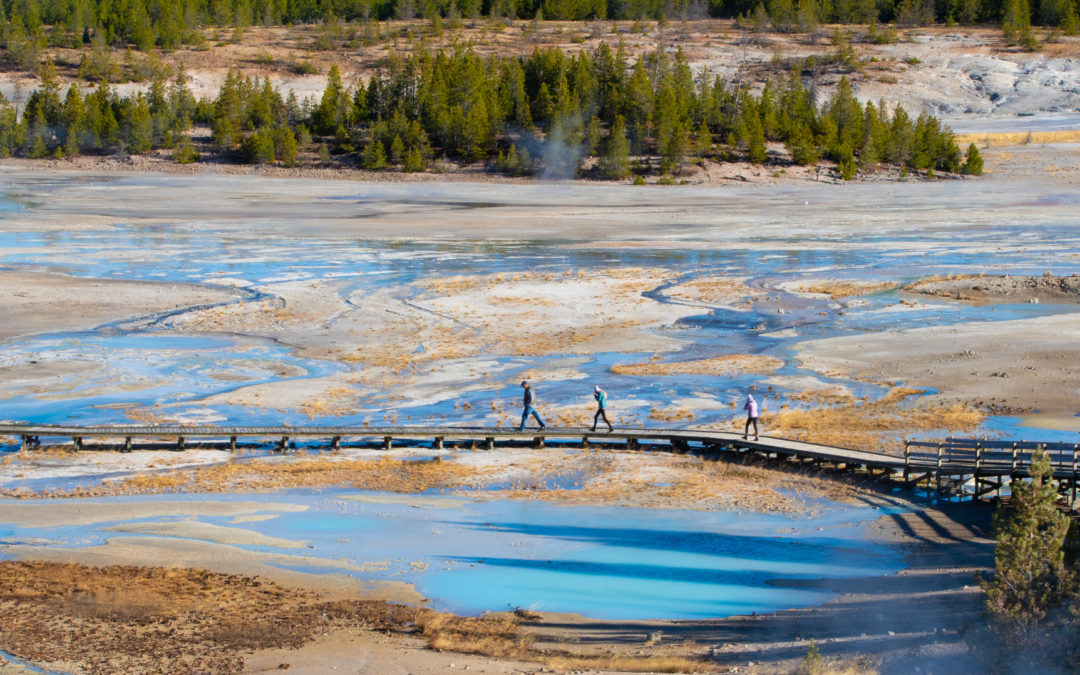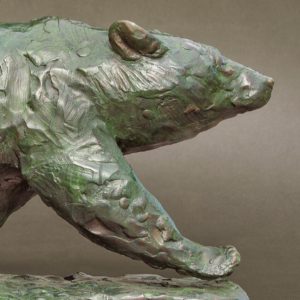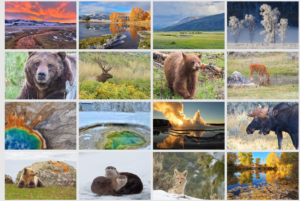Planning a trip to Yellowstone? Here are eight things you need to know before visiting Yellowstone National Park to help make sure you have a great trip.

1. Book your Yellowstone lodging early
It’s a very good idea to know where you are going to sleep before you get here. Don’t just show up without a plan for where you’ll rest your head. Hotels and campgrounds fill up fast in Yellowstone, with lodging inside of the park often filling up 6 months to a year in advance.
Seven of the twelve campgrounds inside the park are first-come-first-serve. It is not uncommon to see 30 vehicles waiting for a site each morning, so reserve your site ahead of time. There are five entrances to the park, all with gateway communities that provide further lodging options for travelers.
For the best park experience, stay close to where you want to visit, or choose multiple basecamps to help lessen your travel time to major attractions during your stay.
2. You can’t see Yellowstone in a day
The park is WAY bigger than you think; it’s impossible to see the whole park in a day, (and some will say even in a lifetime). There is so much to do in Yellowstone—wildlife watching, geyser gazing, hiking, biking, canoeing, fishing, horseback riding, or backcountry camping—it’s too easy to be tempted to pack it all in. Don’t do it! Some of your most memorable parts of the trip will be the little unexpected treasures you find along the way, so be sure to leave time for serendipity. For the best park experience, plan to stay for a few days, but most importantly, take a slower approach to enjoying what you can see and do in the time that you have.
3. Yellowstone is huge! Everything will take longer than you think
Pack your patience! The Grand Loop Road encompasses over 142 miles of winding and narrow roads. Long driving distances between each attraction, a slow speed limit, limited parking spaces and unexpected wildlife jams may slow your progress. Do not be fooled by Google Maps. The general rule of thumb is to double the driving miles to calculate your drive-time (20 miles = 40 minutes). So sit back and enjoy the ride.
4. Your phone won’t work outside of major developed areas
Once you enter Yellowstone, cell service is often limited to developed areas, such as Mammoth Hot Springs, Canyon VIllage, Old Faithful, Grant Village, Lake Village, and Mount Washburn. Numerous users can strain the system so browsing is slow. Texting is often the most efficient means of communicating.
There is free wifi at the Albright Visitor’s Center in Mammoth Hot Springs, and internet access is available to registered guests at many of the hotels and lodges. Bandwidth is limited however, and not very reliable.
Download the NPS Yellowstone App, the GyPSyGuide to Yellowstone and Grand Teton, and any other travel apps, books music, work emails, etc. and make them available offline BEFORE you enter the park.
While it may seem old school, be sure to print a paper map, pick up one at a visitor center, or use the map given to you at the park entrance. They are very important for navigating the park when your phone doesn’t work.
5. The park is beautiful year round
While most visitors to Yellowstone come in the summer months, you can actually visit Yellowstone year-round. If you want to avoid the crowds (see #6) you might want to consider coming in another season.
In spring, (Mid-May through Early June), the park will be far less crowded, and if you can handle unpredictable weather, the spring babies will be arriving and the wildflowers will be pushing their way through the last of the winter snows.
To really experience the quieter side of Yellowstone, consider coming to the park in the winter (mid-December-early March). With frost covered trees and plumes of steam coming off of the thermal areas, visiting Yellowstone in winter is like walking through snow-globe!
For more information about when to visit, see this guide to The Best Time to Visit Yellowstone.
6. Yellowstone is crowded in the summer…
…really crowded: most of Yellowstone’s over 4 million visits occur in the summer months!
If you have to come in the summer, the keys to surviving the crowds are rise early, take hikes away from busy roadways, pack a picnic lunch, and take your time – don’t rush to get it all in. Truthfully, you won’t be able to avoid Yellowstone’s summer crowds entirely. You can’t get from point A to B in the park without encountering many other people doing so. However, these tips will give you the best chance at enjoying the best the park has to offer, while leaving much of the traffic and crowds behind.
7. It’s really important to be prepared for your Yellowstone trip
Yellowstone rests on a high elevation plateau, which means that the weather can change quickly and drastically. Your days can be quite long and full of unexpected adventures, so you’ll need a few things with you each day to prepare you for Wonderland.
- Prepare for all four seasons in a day. It can snow any month of the year here, even in July! You’ll need warm layers and rain gear. Pack your sunscreen, sunglasses and chapstick, no matter what time of year! The high elevation means those UV rays are breaking through, even on a cold or cloudy day. You’ll also need to stay hydrated. Bring or purchase a reusable water bottle. The high elevation also means dehydration can happen fast.
- Pack your hiking boots or comfortable walking shoes. The best way to get away from the crowds and explore the secret side of the park is to go for a walk. You don’t need to go out and buy a brand new pair of boots, but bring something that is comfortable and can keep you dry. Even if you don’t go for a “hike” you’ll still need to walk quite a bit to explore the geyser basins.
- You’ll need to carry bear spray. If you are going to hike in the park, don’t leave the car without it. If you are flying, you won’t be able to travel with bear spray, so you’ll need to purchase it in the park when you get here. Bear spray rentals are also available at Canyon Village.
- Bring a daypack. If you are going to walk the boardwalks or go for a hike, you’ll want to bring a day pack for carrying water, snacks, lunch, warm layers and rain gear. Look for one that has a waist strap or chest strap for carrying bear spray in an easily accessible location—carrying bear spray in a side pocket of a pack or a pants pocket is NOT recommended.
- Don’t forget binoculars. Wildlife abounds in the park and many can be seen from the car, but to really experience this wild kingdom and do it safely, you will need a pair of binoculars. If you are really into the wildlife, you may also want to buy or rent a spotting scope to help you see those far-away animals up close in the safest way. You can even do a bit of stargazing with that spotting scope!
For more on what to bring, see Yellowstone Packing Lists for Every Season.
8. Yellowstone is NOT Disneyland; your safety is your responsibility
Hazards abound in the world’s first national park, requiring visitors have to take responsibility for their own safety. Don’t become a statistic! Be sure to read the park newspaper you get when you enter the park, and read and adhere to directions on all signs. Here are a few specifics you’ll need to know to stay safe.
A. Yellowstone is a volcano. You will be traveling on top of the world’s largest active volcano. To stay safe and enjoy the thermal areas, you’ll want to stay on the boardwalks and trails at all times.
A major cause of injury in the park is being scalded by hot water, either because someone walked off the trail and broke through the surface or they put their finger in the hot springs to “test” the temperature.There is are few railings to protect you from hazards in the park; you’ll need to be aware of boundaries and edges and keep children close. Many visitors have fallen into the springs or off the cliff edges while attempting to get just a little bit closer, often for a photo.
B. The wildlife are TRULY wild. Yellowstone is not a petting zoo! The wildlife here are wild and dangerous, even when they seem tame.
The National Park Service asks that visitors maintain a minimum distance of 100 yards from bears or wolves and 25 yards from everything else. These rules protect both the animals and you.
Remember, if an animal is looking at you, or has to change their behavior because of your actions, they are not taking care of themselves. These animals have a 6 month-long winter to prepare for each year, and need to store up on proper foods to survive. Eating your tasty bag of potato chips will only endanger them.
Although bears are present throughout the park, bison actually cause the most injuries each year. You’ll want to give them plenty of room to go about their day. If you find yourself in a “bison jam,’ keep your car moving slowly and they will move. If you stop, they will stop. Many visitors have made the mistake of touching them out the window, only to have the bison destroy their car.
C. Traffic is the biggest hazard to people and animals. Drive slow and use pullouts. Remember that wildlife and people could be standing in the road just around the next bend.
Plan ahead to avoid driving through the park at night, but if you do, take extra precautions. Bison are nearly invisible at night.
Use the pullouts to pull over to let other cars pass so you may drive slower and enjoy the views without causing a potential hazard. If you are going to pull off the road, the Park Service asks that you have all four wheels off of the road. Be careful while watching wildlife from the roadside, as other tourists will be trying to see what you are looking at and not necessarily looking at the people in the road.
A little bit of advance planning and preparation are all you need to make sure you have an amazing Yellowstone experience.
Need help planning your trip? Check out Yellowstone Trip Planning with one of the best guides around, Shauna Baron.
And have a great trip!
Shauna Baron studied large and small carnivores, and has been sharing her love for the natural world with students of all ages for more than 20 years. She has spent the past 14 years living at Yellowstone’s north entrance, guiding natural history, geology and ecology programs in the park.
Photo © Jenny Golding



